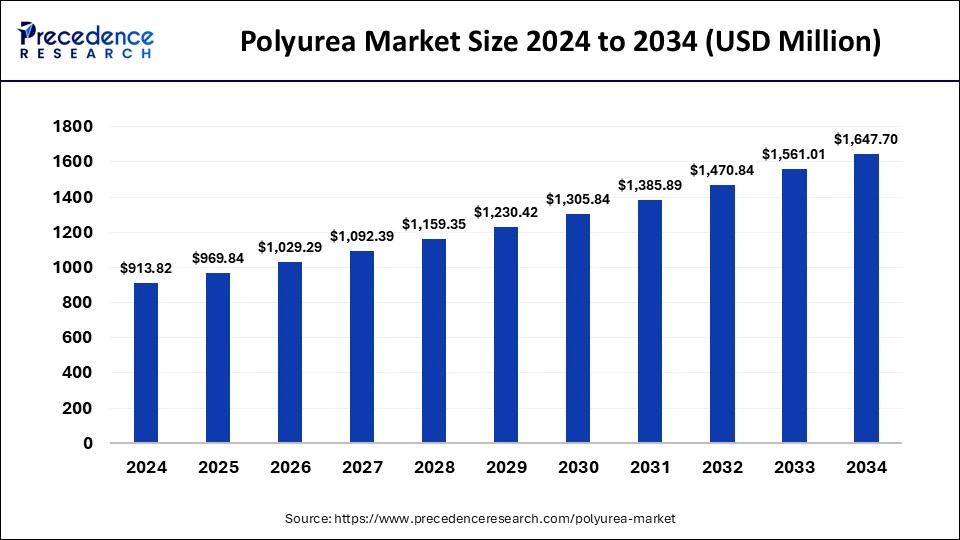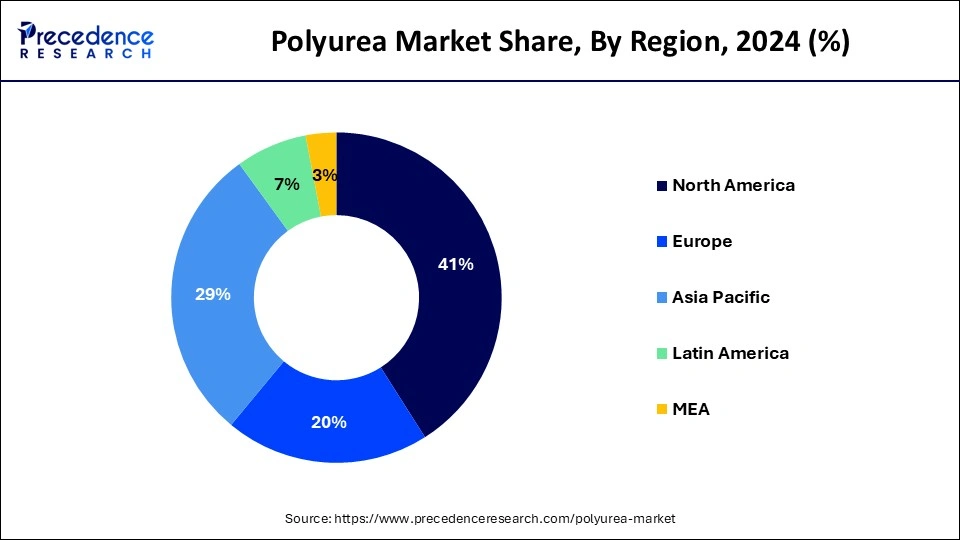Polyurea Market Size and Growth 2025 to 2034
The global polyurea market size was estimated at USD 913.82 million in 2024 and is predicted to increase from USD 969.84 million in 2025 to approximately USD 1,647.70 million by 2034, expanding at a CAGR of 6.07% from 2025 to 2034. The growth of these end-use industries is expected to propel the growth of the polyurea market over the forecast period.

Polyurea Market Key Takeaways
- In terms of revenue, the global polyurea market was valued at USD 913.82 million in 2024.
- It is projected to reach USD 1,647.70 million by 2034.
- The market is expected to grow at a CAGR of 6.07% from 2025 to 2034.
- North America dominated the market with the largest revenue share of 41% in 2024.
- Asia Pacific is expected to host the fastest growing market during the forecast period.
- By raw material, the aromatic segment has held a major revenue share of 69% in 2024.
- By raw material, the aliphatic segment is expected to grow at the fastest rate in the market over the forecast period.
- By product, the coating segment has contributed more than 68% of revenue share in 2024.
- By product, the lining segment will show rapid expansion in the market during the forecast period.
- By application, the construction segment has generated more than 45% of revenue share in 2024.
- By application, the industrial segment is expected to grow at a significant rate during the period studied.
U.S. Polyurea Market Size and Growth 2025 to 2034
The U.S. polyurea market size surpassed USD 281 million in 2024 and is projected to attain around USD 518.79 million by 2034, poised to grow at a CAGR of 6.32% from 2025 to 2034.

The polyurea market was dominated by North America in 2024. The increased spending on hydraulic fracturing in the U.S. and Canada led to improvements in the shale gas industry, which is expected to drive the demand for polyurea as coatings and lining systems. However, slow growth in the manufacturing sectors of developed countries, such as Canada and Mexico, along with rising utility costs, is anticipated to reduce the consumption of polyurea for sealants and coatings.
- In June 2022, BASF announced the increase in the production capacity for key specialty amines manufactured at its Geismar, Louisiana site. After the completed production capacity expansion of a flexible world-scale production asset by mid-2023, BASF will be able to produce more of its key polyether amines and tertiary amines marketed under the Baxxodur and LupragenTM brands.

Asia Pacific is expected to host the fastest-growing polyurea market during the forecast period. The growing use of coatings and rising demand from the automotive sector are driving the growth of the region in the global polyurea market. Asia Pacific offers affordable raw materials, low production costs, and the ability to better serve the local developing market. Additionally, the region has seen an increase in the higher-middle-class population with significant purchasing power in recent years, which has substantially increased demand.
- In March 2022, Graco Inc., a leading manufacturer of fluid handling equipment, introduced the Reactor 3™ spray foam proportioner system, the newest member of the Reactor proportioner family. The Reactor 3 system delivers next-generation intelligence and capability, allowing contractors to maximize material yield, productivity, and profitability. This new product comes in three product tiers.
Market Overview
Polyurea is an elastomeric substance produced through the reaction of an aromatic or aliphatic isocyanate component with a synthetic resin blend via step-growth polymerization. It can exist in forms ranging from monomers to polymers or any other reaction product of isocyanate, quasi-prepolymer, or prepolymer. Polyurea is known for its exceptional elongation properties, high tensile strength, and tear resistance. Due to these qualities, it is widely used in the construction and industrial sectors.
Polyurea coatings, which are intrinsically superior to epoxy coatings, are increasingly replacing them in industrial and commercial buildings and infrastructure due to their versatility and high impact resistance. Furthermore, polyurea finds application in various fields, such as manufacturing and transportation, thanks to its unique characteristics, including rapid curing time, high thermal stability, and color consistency.
Polyurea Market Growth Factors
- Rising requirements for coating solutions, along with specifications such as enhanced service life and improved corrosion resistance, can drive the polyurea market.
- The expanding construction industry is likely to fuel the growth of the polyurea market.
- Key players are constantly working on developing polyurea components, and this is expected to boost market growth further.
- Increasing the use of polyurea in the automobile sector to reduce car weight can propel the growth of the polyurea market.
Market Scope
| Report Coverage | Details |
| Market Size by 2034 | USD 1,647.70 Million |
| Market Size in 2025 | USD 969.84 Million |
| Growth Rate from 2025 to 2034 | CAGR of 6.07% |
| Largest Market | North America |
| Base Year | 2024 |
| Forecast Period | 2025 to 2034 |
| Segments Covered | Raw Material, Product, Application, and Regions |
| Regions Covered | North America, Europe, Asia-Pacific, Latin America, and Middle East & Africa |
Market Dynamics
Driver
Environmentally friendly nature
The primary driver for this product is its environmentally friendly nature and compliance with the environmental standards regarding Volatile Organic Compounds (VOCs), as set by regulatory bodies. Increasing urbanization has expanded its applications in the transportation and construction sectors. Its coating solutions are commonly used in construction and automotive industries for repairing bridges and tunnels, constructing highways and roads, and coating vehicles. The rapid growth in infrastructure spending and focus on enhancing public transportation, building subways, and urban development are creating favorable conditions for industry.
- In May 2024, ArmorThane announced the launch of an innovative Polyurea coating specifically designed to enhance the longevity of RV roofs. This development promises to revolutionize the industry by offering an advanced solution for RV roof coatings and RV roof repair.
Restraint
High cost and toxic effects
Polyurea-based coatings are widely used across various sectors. However, their higher cost compared to other coatings is hindering the growth of the polyurea market. Coatings based on epoxy and acrylic are available at lower prices than polyurea coatings, leading to a notable decline in demand for polyurea-based coatings in recent years. Additionally, the raw materials used in producing polyurea-based products are toxic.
Opportunity
Increasing demand in medical facilities
In response to the COVID-19 pandemic, countries worldwide have initiated efforts to build more secure and advanced medical facilities. Concerns about safety in medical settings are expected to create favorable conditions for the expansion of polyurea coating manufacturers. Polyurea coatings are used in hospital flooring and as a waterproofing solution for various infrastructure elements. Many medical facilities have extensive flooring areas or miles of sidewalks that require large volumes of coatings. Hence, manufacturers of polyurea coatings are expected to experience significant demand for their products in medical facilities.
- In August 2023, Novasafe, the newest product from Induron Protective Coatings, was launched. Novasafe is a furfuryl-modified, thick-film, ceramic-filled novolac epoxy resistant to the harshest treatment plant environments.
Raw Material Insights
The aromatic segment dominated the polyurea market in 2024. These raw materials offer excellent physical properties and are easy to process. Therefore, aromatic systems are coated with aliphatic topcoats to achieve the desired color stability when exposed to UV light. Due to their outstanding flexibility, polyurea compounds based on aromatics are anticipated to be used in the construction and manufacturing industries of developed nations such as Germany, the UK, and Spain.

The aliphatic segment is expected to grow at the fastest rate in the polyurea market over the forecast period. Aliphatic polyurea is resistant to UV radiation and is excellent as a final coat. However, due to the high cost of its raw materials, it falls into the higher price range of polyurea products. Factors such as favorable demographics for production and a growing global population are expected to drive the aliphatic segment in the market.
Product Insights
The coating segment led the global polyurea market in 2024. The growing significance of polyurea coatings in the aerospace, construction, oil & gas, and automotive industries is fueling the expansion of coatings in the product segment of the polyurea market. Increased construction activity and urbanization have notably increased the demand for coatings in the market. These factors collectively drive the growth of coatings in the product segment of the polyurea market.
- In October 2023, a Leading Dubai-based waterproofing specialist and protective coatings system house, Delta Coatings International, announced its ambitious three-year strategic growth plan for the Middle East. The expansion will include opening a new facility in Saudi Arabia and strengthening representation in Oman and Egypt in addition to launching innovative products.
The lining segment will show rapid expansion in the polyurea market during the forecast period. Polyurea lining is ideal for corrosion control, immersion applications, and waterproofing. Items such as bed liners, pond liners, tank liners, and more are also included. It offers excellent adhesion to properly prepared surfaces.
Application Insights
The construction segment dominated the polyurea market in 2024. The expanding use of polyurea in construction, including residential and commercial buildings and other infrastructures, is driving growth in the construction segment of the polyurea market. Polyurea is extensively used in the construction industry for coatings, adhesives, linings, and similar applications. Its excellent physical properties promote its widespread use across various industries.

The industrial segment is expected to grow at a significant rate in the polyurea market during the period studied. When applied as a liquid coating, it quickly cures to form a durable, waterproof barrier. It is also used for waterproofing roofs, foundations, decks, and other surfaces. Polyurea is a waterproofing material commonly used in industrial and commercial settings to protect surfaces from water damage.
Polyurea Market Companies

- BASF SE
- Huntsman Corporation
- Bayer AG
- PPG Industries
- Dow Chemical
- Specialty Products, Inc.
- Versa Flex, Inc.
- SWD Urethane
- Alberts Spray Solutions, LLC
- W.R. Grace & Co.
- LINE-X Protective Coatings
- Nukote Coating Systems International
Recent Developments
- In July 2023, Delta Coatings International, a Dubai-based waterproofing specialist and provider of protective coatings system, announced its ambitious three-year strategic growth plan for the Middle East, concentrating on the key markets of Oman, Egypt, and Saudi Arabia.
- In February 2022, PPG Industries Invested USD 10 Million in the development of an 82,000 sq. ft. production facility and painting line at its Greenville, South Carolina, coatings facility.
Segments Covered in the Report
By Raw Material
- Aromatic
- Aliphatic
By Product
- Coating
- Lining
- Adhesives & Sealants
- Others
By Application
- Construction
- Industrial
- Transportation
- Others
By Geography
- North America
- Asia Pacific
- Europe
- Latin America
- Middle East & Africa
For inquiries regarding discounts, bulk purchases, or customization requests, please contact us at sales@precedenceresearch.com
Frequently Asked Questions
Ask For Sample
No cookie-cutter, only authentic analysis – take the 1st step to become a Precedence Research client
 sales@precedenceresearch.com
sales@precedenceresearch.com
 +1 804-441-9344
+1 804-441-9344